Valencia History Museum
| Valencia History Museum | |
|---|---|
| Museo de historia de Valencia | |
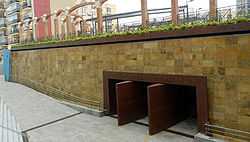 | |
 Location within Valencia | |
| Established | May 7, 2003 |
| Location | C/ Valencia, 42 Mislata, Valencia, Spain |
| Coordinates | 39°28′21″N 0°24′30″W / 39.472611°N 0.408222°WCoordinates: 39°28′21″N 0°24′30″W / 39.472611°N 0.408222°W |
| Director | Javier Marti Oltra |
| Website |
www |
Valencia History Museum (Catalan: Museu d’Història de València, Spanish: Museo de historia de Valencia — MhV) was inaugurated May 7, 2003.
The mission of the Valencia History Museum is to teach visitors about the historical development of the city of Valencia and make it known. The MhV shows the past of Valencia in a didactic and entertaining way, using traditional exhibition resources and new technologies.
The project

Valencia History Museum (MhV) was created in agreement with the Commission of Government of the Valencia City Council January 12, 2001 with the mission to promote the history of the city, from the origins to the nowadays using the local archaeological, artistic, and cultural heritage.
The MhV is located in the former city deposit of drinking water, built in 1850 by Ildefonso Cerdá and Leodegario Marchessaux. The building was designed by Calixto Santa Cruz and represents a beautiful example of the Valencian industrial architecture as the first engineering project in Valencia in the nineteenth century.
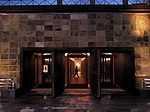
The restoration of the building war performed by the City Council between 1998 and 2001. The restoration works were hold with a great respect towards the architectural heritage. So we can enjoy a real site of beauty where nowadays the Museum is located.
The MhV aims to approach the history of Valencia to the visitors, to give them a more deep imaging of the past and the traditions in an entertaining way although keeping close to the historical rigour. The Museum looks forward for desplaying the history of the city of Valencia as something close, intelligible and amusing and also trying to distance the political history, the dates, the battles or the famous people and reveal the social background, the economic motives, the ideology and the customs.
MhV was awarded by the “Diputación de Valencia” as Cultural Project of the year 2003.
The building
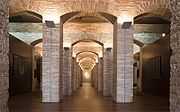
The Museum is located in the first deposit of drinking water in Valencia which was built by Ildefonso Cerdá (who later designed the Eixample of Barcelona) and Leodegario Marchessaux for the needs of the city. The water deposit was inaugurated in 1850 and became the first of its kind in Spain. Totally built of bricks, it is one of the most beautiful piece of art of industrial architecture in the ninetieth century. The mere contemplation of the arcades suggests a feeling of serenity and peace and seduces the gaze. Formerly unknown to the general public the building now is joined to the beauty of the space.
The location is relatively away from the old city, but the neighboring Parque de Cabecera, not far than 100 meters, provides an easy access to the city center.
Besides the Museum, the Parque de Cabecera includes the Bioparc, one of the most innovative zoos in the world, where you can watch the animals in apparent freedom. Zoo ambience is dedicated to leisure with a wide cultural and environmental offer. It is a place of undeniable attraction for the inhabitants of Valencia and the tourists.
On display
The MhV exposes a permanent exhibition dedicated to the history of Valencia, which contains eight periods:

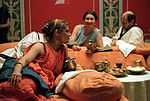
- Valentia (138 b.c.-711)
- Balansiya (711-1238)
- Valencia in the Middle ages (1238-1519)
- The “Germanías” to the “Nueva Planta” (1519-1707)
- Borbonicus municipality (1707-1833)
- the City of steam (1833-1917)
- Truncated Modernity (1917-1975) and
- the Valencia we have lived (1975-2003)
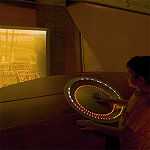

Each period shows a collection of the objects, the documents and the works of art, which are witnesses to their time. In the center of each block, there are two stages reconstructing historical ambiance of the city and projecting everyday scenes proper to the every epoch, so the visitor can choose any epoch to his convenience and meet the historical characters plunging into the world of experiences and aspirations.
This is a format halfway between a Museum and a cinema, which entitles us to replace much textual information with more dynamic resources.
The visitors can see everyday scenes that refer to the circumstances and the characters of each period, thus being able to get to know the protagonists of the history of Valencia.
The showcases expose a very heterogeneous collection that includes from archaeological objects to artistic works, archival documents, books, prints, maps, posters, machines, vehicles or toys, among others, gathered not so much by their individual value as by his ability to evoke moments and contexts of history.
In addition, the MhV welcomes regular temporary exhibitions on the generic topic of the city, in all its manifestations, and the history of Valencia in particular, and proposes a didactic programme to all audiences. You can be guided tours or request specific workshops.
The Museum has an equipment that recreates, using virtual reality, the appearance of the city for its twenty-two centuries of history: “La máquina del tiempo (The Time Machine)”. The visitor can choose a time and browse it to birdseye, obtaining an avalanche of historical data on the city of the time in his walk.
The “Mediateca (media library)”, finally, is a space designed to rest and reflection, where the visitor can enjoy hearing recited poetry or musical fragments of every moment in history, see old photos of Valencia and its inhabitants or freely consult a careful selection of works on the city.